The First 100 Years of St Johns School

On the 4th May 1872, the first entry in the Head Teacher’s Log Book was made by Mrs Mary Seaman, the first Head Teacher. _ To view School Gallery Click Here
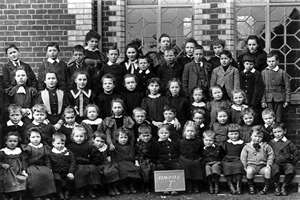 The Education Act of 1870 required provision be made for all children to have the opportunity for an education. Prior to this date few children, other than those from wealthy families, were able to attend any type of school. At Cromer Hyde there was a ‘Dame School’ run by Miss Archer for about forty children whose parents paid 2d (about 40p in today's money) per week for each child. St Mary’s School in nearby Welwyn had been established some years before but it was too far away for the children of Lemsford. In order that these children should have their own school Lord Cowper, who at the time owned the Panshanger and Brocket Estates, had a school built in 1872 and which he supported financially until 1903. CLICK ON IMAGE TO ENLARGE
The Education Act of 1870 required provision be made for all children to have the opportunity for an education. Prior to this date few children, other than those from wealthy families, were able to attend any type of school. At Cromer Hyde there was a ‘Dame School’ run by Miss Archer for about forty children whose parents paid 2d (about 40p in today's money) per week for each child. St Mary’s School in nearby Welwyn had been established some years before but it was too far away for the children of Lemsford. In order that these children should have their own school Lord Cowper, who at the time owned the Panshanger and Brocket Estates, had a school built in 1872 and which he supported financially until 1903. CLICK ON IMAGE TO ENLARGE
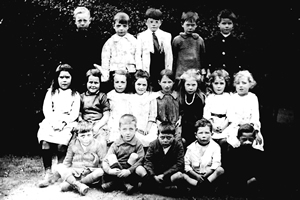
The first day in 1872
On the 4th May 1872, the first entry in the Head Teacher’s Log Book was made by Mrs Mary Seaman, the first Head Teacher. On that day, seventy-seven children, ranging in age from three to thirteen, were enrolled. They were divided into two classes - one being taken by Mrs Seaman and the other by her husband Walter, her assistant. They were all taught in one room, the room now used as the dining room in the oldest part of the school. The school was approved by the Government on the 16th May 1872.
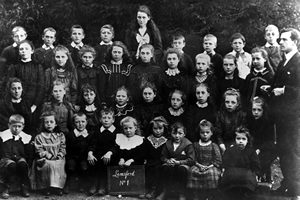
First pupil Teacher in 1874
When the school first opened, the staff consisted of the head teacher and one assistant. Miss Digby’s sister was employed as the first pupil teacher in 1874. Emma Binns served as a pupil teacher and then proceeded to Hockerill Training college in Bishops Stortford later the same year. Later intending teachers were drawn from the ranks of the pupils at the age of thirteen if they showed promise. They would receive special tuition from the head teacher before the school opened at 9am. The pupil teachers received an annual grant of one sovereign each (in 1890 £1 was worth nearly £60.00). In addition to these intending teachers, monitors were also employed to help look after the infants.

The girls were taught needlework, and the boys gardening
Few of the children had any idea of numbers or of letters, and the first task was to teach them to read and write and do simple arithmetic. The girls were taught needlework, and the boys gardening, and all the children learned to sing. The Vicar the Revd. Fred Burnside, opened the school each morning with prayers, and made himself responsible for the teaching of scripture to the older pupils.The children were admitted from the age of three upwards. Younger children were allowed to attend provided they were entered on a separate register.
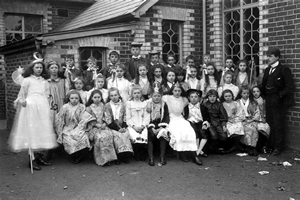
School fees of 2d a week
The pupils were drawn from a wide area surrounding the school; from Handside to Cromer Hyde and as far as Astwick and Coopers Green. The majority of families worked on the land. Wages were very low, and many parents found it difficult to pay the school fees of 2d a week, although the fees of some children were paid privately or by the parish. In 1876 the parish refused to pay for children under five. A national conscience about the employment of children was slow to develop and many children were kept at home to work on the farms.
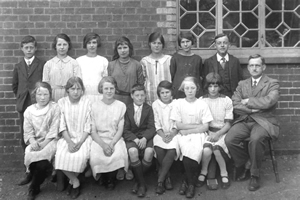
The maximum fine for non compliance was 5 shillings
Children aged 5 to 13 were required by law to attend school for a minimum of 250 sessions per year, unless they were unavoidably absent through sickness. The maximum fine for non compliance was 5 shillings (about £12.00 in today's money. Lack of suitable clothing, many children had no footwear, was responsible for large numbers being absent in bad weather and after heavy snowfalls very few children were present as the roads became impassable. The Hon H.P. Cowper made an annual gift of boots to the boys and cloaks to the girls, and until his death in 1887, provided treats in Brocket Park. He was sadly missed and was a great friend to the school. A year before his death he had provided the children with soup twice a week in cold weather.

Many would go nutting and collecting acorns in Brocket Park
Each year there are reports of children being absent for various reasons other than sickness or bad weather. Many would go nutting and collecting acorns in Brocket Park in the autumn. Whole families were permitted to go wooding to gather winter fuel. The boys were often required as beaters when there was a shoot in Brocket Park. So many children were required to help on the farms to bring in the harvest that the school was closed in common with most others in the country. This gave rise to the long summer holidays now taken in August and early September.
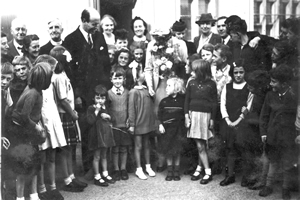
Lady Mount Stephen, presented the school with a canteen in 1905.
It is known that many children were from poor families, and they must have often been very hungry. In 1875, two children were caned for eating another child’s dinner. School dinners as now known were not provided until 1942, but it was recorded by Mr Ladbury in 1914 that he supplied soup for those who wanted it at a halfpenny for about ¾ of a pint. This was prepared from fresh beef, potatoes, carrots, parsnips, beans, peas and pearl barley. Lady Mount Stephen, then resident at Brocket Hall, presented the school with a canteen in 1905. She had noticed that the children had nowhere to play or to eat their dinners in wet weather.

‘Eton’ collars, jackets and knickerbockers'
From photographs it can be seen that, at the end of the 19th century, the boys were wearing ‘Eton’ collars, jackets and knickerbockers, the older girls wore dresses similar to those of their mothers with many pleats and decorated with ribbons, whilst the younger children wore smocks. Clothes were provided by Lady Mount Stephen. She also provided treats in Brocket Park in the summer time and gifts at Christmas.
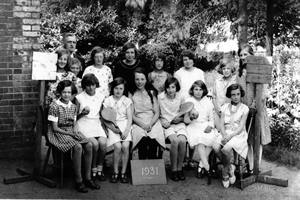
1936 the school was presented with a radio receiver
The number of children attending the school steadily rose during the first years and in 1881 there were 100 pupils. The official plan was for the school to accommodate 120 pupils. This was physically possible but meant that three or four classes had to be held in each room. In 1883 Her Majesty’s Inspector recommended that the school should enlarged. A new classroom was completed in 1887 and, apart from some extensions in 1897, the buildings were to continue unchanged until the gallery in the infants room was removed in 1933. This had been recommended in 1918 by H.M.I. as had improvements to the toilet and washing facilities. But it was not until 1950 that work commenced on a new toilet block which was completed in 1952. Up to this time conditions had been very primitive.
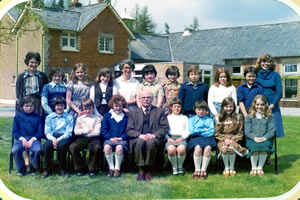
1970 two new classrooms and a new kitchen were added
In July, 1970 two new classrooms and a new kitchen were added and various other improvements made. The latter included the removal of a chimney breast in the old building and the provisions of three plain glass windows. The heating system was renewed and hot water provided for the kitchen.The school has gone on from strength to strength and today has a high standard of education and is still popular wit local people

Frank Lines a little boy aged eight, saved James Cochrane
My favourite story is about Frank Lines, who at the age of eight was mentioned in the ‘Strand Magazine’ May 1893. ‘Frank Lines a little boy aged eight, saved James Cochrane on 28th December, 1891, in Broadwater, Brocket Park, Hatfield. Cochrane ran after a ball on the ice and when forty five yards from the bank the ice broke.He managed to cling to the edge for some time. The other boys who were present ran away, but Frank Lines crawled to the hole and with the aid of a stick got Cochrane out. The ice again gave way and Cochrane fell in once more, but still his little rescuer made another attempt, and finally saved him’.School visited in afternoon by Col. Fellows, Rev. F.E. Coggins and Mrs Coggin, and a gentleman. Col. Fellows presented, on behalf of the Royal Humane Society, a silver medal to Frank Lines for having saved James Cochran from drowning’ Extract from Lemsford school log book March 1892. Image shows Frank on the right with a medal on his jumper (Click to enlarge)
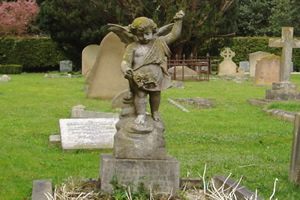
The death of Brenda Edith Lines
The above story is tinged with sadness as frank Lines in his adult life lived in an area called Stanborough in a cottage called Bury Cottages. He was married and had only one child a girl called Brenda, here is an extract from the ‘Herts Advertiser’‘The death of Brenda Edith Lines, the six year old and only daughter of Mr Frank Lines of 8 Bury Cresent, Stanborough, near Hatfield, who reported in last weeks ‘Herts Advertiser’ was run over and killed by a motor car, was the subject of an inquest held by Mr Longmere last Friday.The driver of the Motor car in question, Mr Arthur Charles Davis of 4 Mount Avenue Ealing, stated that he was driving the car on the day in question. Sitting in front with him was his wife, and his two children were behind. On nearing the Bull public house Stanborough, he saw three children run into the road from the right hand side. At the time he was travelling at about fifteen miles per hour. He sounded his horn and felt for his footbrake. Two of the children ran back, but the other hesitated, looked back and then ran straight into the car. The left hand side lamp came into contact with the child, and he imagined it hit her on the shoulder. Witness pulled up in about two lengths, got down from the car and dispatched two persons for a doctor and police. Elaine Davis, wife of former witness, corroborated her husbands evidence, and stated that it was impossible to avert the accident.’The funeral took place at St John Church LemsfordOn Saturday afternoon. The Revd W.W. Clarke(Vicar) Officiated and many relatives and friends attended. TheGrave was beautifully lined and covered with flowers by Mrs Baily King and Mrs Ladbury. Lady MountStephen having sent the flowers for this purpose. The Floral tributes were numerous.
Many of the Schoolchildren who were on holiday sent wreaths toMark their mourning for their departed playmate.Herts
Advertiser April 29th 1922
The Queen paid a visit to Brocket Hall, After lunchingWith Lady Mount Stephen, her Majesty and her hostessVisited Lemsford churchyard, She placed a wreath on The grave of Lord Mount Stephen. She also Sympathetically inspected the flowers on the grave of Little Brenda Lines, the six year old victim of the Recent motor car fatality
We are a happy, caring school which aims high in all we do. Our vision for St John’s is shaped by our shared Christian values and driven by a desire for all at St John’s to embrace challenge and grow.Read More
In 1872, Lord Cowper, who at that time owned the Panshanger and Brocket Estates, had the school built for the children of Lemsford and the surrounding areas which he supported financially until 1903.
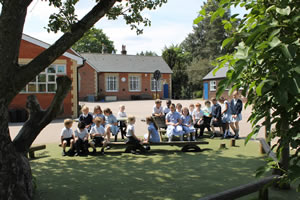 On 4 March 1872, seventy-seven children were enrolled into two classes. The number of children on role has now risen to over 100 and the Victorian School House has been added to over the years to accommodate more children and modern education. We now have a wonderful new hall and the addition of a new classroom. Read More
On 4 March 1872, seventy-seven children were enrolled into two classes. The number of children on role has now risen to over 100 and the Victorian School House has been added to over the years to accommodate more children and modern education. We now have a wonderful new hall and the addition of a new classroom. Read More

